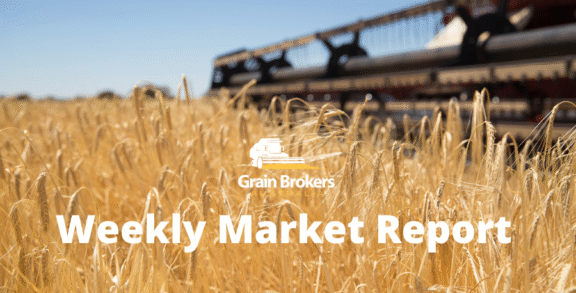Strong rumours circulated in international grain markets late last week that Türkiye may extend its wheat import ban beyond the previously announced October 15 end date. The speculation suggested that imports may not resume until December, or even the New Year, despite a harvest outlook slightly lower than early forecasts.
On June 6, the Turkish Ministry of Agriculture and Fisheries announced that it would pause wheat imports under the Inward Processing Regime from June 21 through mid-October to protect the country’s farmers from price decreases and other adverse impacts during this year’s harvest. The ministry also noted at the time that the ban could be extended beyond October if conditions warranted.
The ministry stated that the drastic measure was being implemented to “prevent our producers from being affected by price decreases due to supply density during the harvest period, to meet the raw material supply required for our exports from domestic production, and to ensure market stability in favour of producers.”
The Agriculture Ministry also announced that exporting flour made from domestically produced wheat, banned since September 2018, would again be permitted. In addition, the government has liberalised the export of barley, milling wheat and durum wheat due to excess carryover stocks from the 2023/24 marketing year, implementing an export licence system that will be controlled by the Turkish Grain Board (TMO).
At the same time, the TMO released new crop intervention prices for wheat and barley. The government will provide payment support of up to 1,750 Turkish Lira per metric tonne (AUD81.00/MT) for wheat and 750TL/MT (AUD35.00/MT) for barley to producers registered in the Farmer Registration System.
With the payment support provided by the Ministry, Turkish producers should expect to receive around 11,750 TL/MT (AUD544/MT) for durum wheat, 11,000 TL/MT (AUD509/MT) for milling wheat and 8,000 TL/MT (AUD370/MT) for barley. With the annual inflation rate running at around 75 per cent, the 12 per cent price increase for wheat and only 4 per cent for barley did not impress local farmers struggling to cope with higher input costs, despite the fertiliser, diesel oil, and certified seed support also provided by the government.
The disruption of trade via the Suez Canal due to the ongoing Houthis attacks on merchant vessels, combined with the Turkish wheat import ban, has already pushed global wheat values lower, particularly of Black Sea origin. Russia has been the biggest loser from the ban, being the primary supplier of wheat to Türkiye in recent years.
According to the Turkish Statistics Institute, wheat imports totalled 6.45 million metric tonne in the first eight months of Türkiye’s 2023/24 marketing year (June 2023 to January 2024), of which 5.33MMT, or 83 per cent came from Russia and 0.89MMT, or 14 per cent came from Ukraine. Final 2023/24 imports ended up at around 9.5MMT despite record domestic production. Over the past five seasons, wheat imports have averaged 10mmt, peaking at a record 12.1MMT in 2022/23.
While Türkiye’s bread consumption per capita is one of the largest in the world, it is not the primary driver of wheat import demand. Since May 2023, wheat imports have been subject to a prohibitive tariff of 130 per cent. However, if the imported wheat is processed into flour or pasta and re-exported, the import tariff is reduced to zero. Türkiye is by far the world’s largest exporter of wheat flour, with shipments of 5.8MMT (wheat equivalent) expected in the 2024-25 marketing year. It is also one of the biggest exporters of pasta.
With this year’s harvest well underway, the USDA’s Foreign Agricultural Service has pegged total wheat production at 18.75MMT, revised 1MMT lower than its early season forecast of 19.75MMT, and 10.7 per cent lower than last year’s record harvest of 21MMT. This is off a harvested area of 7.25 million hectares, up from 7.2 million hectares in 2023. Durum wheat makes up 22.4 per cent of the estimated output at 4.2MMT.
Rainfall across Türkiye’s primary cropping areas between October 1, 2023, and June 30, 2024, was estimated at 515 millimetres. This is in keeping with the long-term average and 3.6 per cent more than last year. However, April was extremely dry, and record-high temperatures were observed in critical grain-growing regions of the country.
The dryness has reportedly led to yield and quality losses in several key production areas, especially in Central Anatolia and the Aegean region. However, protein content has remained high in most areas, typical of a dry finish. Expected increases in production in southeastern Turkiye and the Thrace region will not be sufficient to compensate for yield losses in the other areas.
Domestic wheat consumption in 2024/25 is forecast at 20MMT, 300,000 metric tonne higher than the previous season. A small demand increase is expected from the stockfeed sector, while the requirement for food-grade wheat, which accounts for around 93.5 per cent of consumption, is expected to remain steady at 18.7MMT.
Following the implementation of the import ban, FAS reduced Turkiye’s wheat import forecast from 8MMT to 6.5MMT, assuming that the import ban will be lifted in October and flour exporters will then readily be able to source the raw materials they need via the international market. However, that number could easily be shaved by as much as another 2MMT if last week’s rumours become reality and imports don’t resume until 2025.
The 2024/25 export forecast remains unchanged year-on-year at 8.5MMT of wheat and flour (wheat equivalent). However, flour exporters are being negatively impacted by the import ban. They are worried that their competitiveness will decrease and will lose some key markets should the ban be extended beyond the October 15 deadline. In the previous marketing year, wheat exports (including flour and wheat products) were 9.9MMT (wheat equivalent), of which 2.2MMT was wheat, 5.5 MMT was wheat flour, 1.9 MMT was pasta, and 300,000MT was bulgur.
The hiatus in Turkish wheat demand means there is already more Russian wheat not only competing into traditional European Union markets but also making its way into some of Australia’s key Asian markets. Destinations such as Bangladesh, Indonesia, Pakistan and Vietnam and have featured prominently in recent Russian export data despite the Red Sea transit issues forcing most vessels to take the longer but safer Cape of Good Hope route. Bangladesh overtook Iran as the third biggest destination for Russian wheat in 2023/24 with 3.8MMT, and shipments to Indonesian and Pakistan were both around 1.6MMT for the marketing year.
With bigger harvests in traditional wheat markets such as Iran, Iraq and Pakistan quelling import demand in the 2024/25 marketing year, Russia is already an aggressive new crop seller. Should Turkiye’s wheat import ban be extended as rumoured, so too will Russia’s wider search for export homes, despite its much smaller harvest outlook.
Call your local Grain Brokers Australia representative on 1300 946 544 to discuss your grain marketing needs.
Written By Peter McMeekin.





